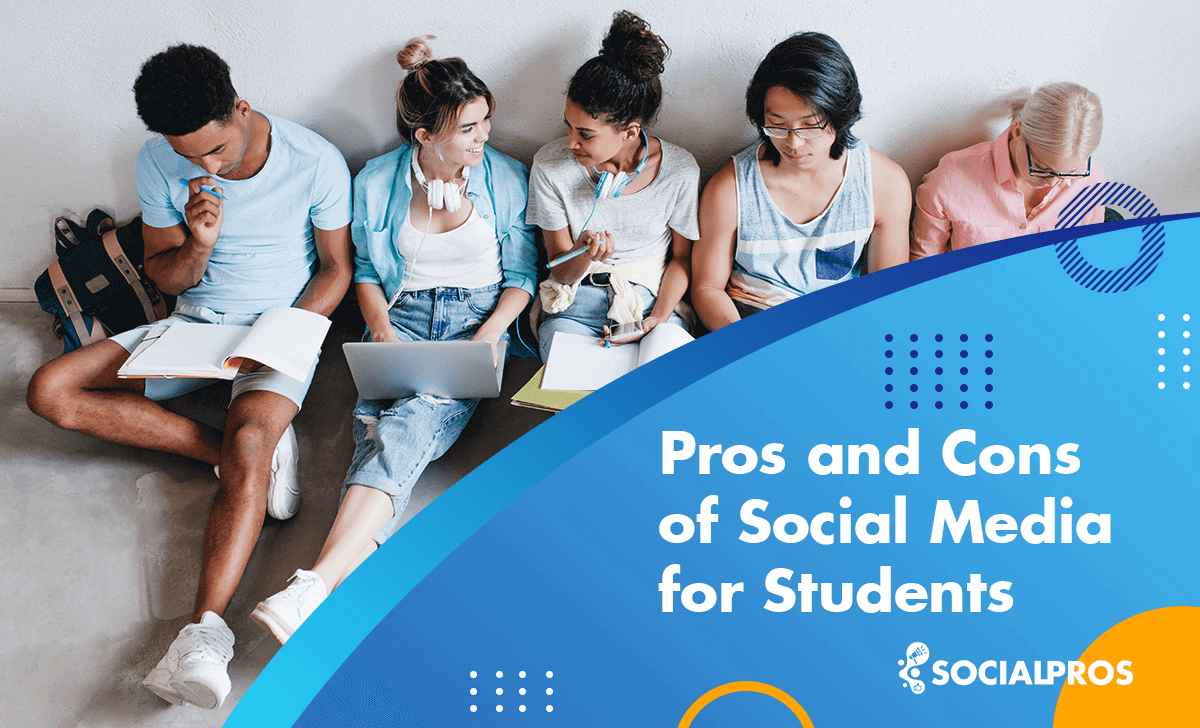Page Contents
In the current era, social media has seamlessly woven itself into the fabric of our lives, transforming the way we communicate, connect, and consume information. This is particularly evident among college students, who find themselves fully immersed in the digital landscape. It becomes paramount to delve into the various advantages and disadvantages that social media holds for students and equip them with the necessary guidance to navigate this ever-evolving digital realm effectively.
The advent of social media platforms has brought about a paradigm shift in how we engage with one another and the world at large. However, it is incumbent upon us to explore beyond the surface-level impact of social media on students’ lives and develop a nuanced understanding of its intricacies.
Read More: Instagram for Students: Top 6 Reasons for its Popularity
The Pros of Social Media for Students
Social media offers numerous benefits that can positively impact students’ lives:
1. Enhanced Connectivity
Social media platforms enable students to connect and stay in touch with friends, family, and peers from all over the world. It allows them to maintain relationships and foster a sense of community, even across geographical boundaries.
2. Access to Information and Educational Resources
Social media for students provides access to educational content, news updates, and resources. Starting from googling ‘pay for essay’ to face timing with friends across the globe, social media for students has ushered in a new era of connectivity and knowledge dissemination.
Educational institutions, experts, and organizations often share valuable insights and materials, contributing to academic growth and expanding knowledge horizons.

3. Platform for Self-Expression and Creativity
Social media offers students a unique platform for self-expression, enabling them to voice their thoughts, ideas, and opinions to a wider audience. It serves as a virtual canvas where students can share their creativity, talents, and unique perspectives with others.
Whether through written posts, visual content, or multimedia creations, social media empowers students to share their passions, engage with like-minded individuals, and leave their digital footprints in the vast landscape of the online world.
4. Networking and Career Opportunities
Social media for student platforms serve as networking hubs, allowing students to connect with professionals, mentors, and like-minded individuals. It offers opportunities to showcase skills, gain exposure, and discover potential career prospects.
The Cons of Social Media for Students
While social media brings forth significant advantages, it is important to be aware of the potential drawbacks it can pose for students:
1. Time Management Challenges
Social media can become a major distraction, impacting students’ productivity and time management skills. Excessive usage and constant notifications may lead to decreased focus and hinder academic progress.
2. Cyberbullying and Online Harassment
One of the darker sides of social media for students is the risk of cyberbullying, trolling, and online harassment. Students may encounter negative interactions that can adversely affect their mental well-being and overall confidence.
3. Impact on Mental Health
Extensive utilization of social media has been associated with detrimental effects on mental well-being, including heightened levels of anxiety, depression, and negative body image. Constant exposure to carefully curated online content may lead to unhealthy social comparisons and feelings of inadequacy.

Navigating the Digital Landscape: Tips for Students
In order to navigate the digital landscape and make the most of social media while avoiding potential pitfalls, students can follow these practical tips:
1- Setting Boundaries and Managing Screen Time
It’s important to establish healthy limits for social media usage. Take time to reflect on your priorities and responsibilities, and ensure that social media for students does not interfere with your academic pursuits or personal well-being. Designate specific periods for focused studying, engaging in hobbies, and practising self-care.
2- Cultivating Digital Literacy and Critical Thinking
Develop your digital literacy skills by learning how to assess the credibility of online sources. Practice fact-checking information before accepting it as true. Nurture critical thinking abilities by approaching online content with a discerning mindset. Be aware of biases and consider multiple perspectives before forming opinions or sharing information.
3- Building a Positive Online Presence
Your online presence should reflect your values and character. Be respectful in your online interactions and adhere to netiquette guidelines. Avoid engaging in cyberbullying or participating in negative online discussions. Instead, focus on showcasing your talents, accomplishments, and interests in a constructive and uplifting manner. Let your online presence be a reflection of your best self.
4- Seeking Support and Guidance
Remember that you are not alone in with best dissertation writing services. Reach out to trusted adults, mentors, or school resources for guidance and support when needed. If you encounter instances of cyberbullying, harassment, or safety concerns, report them to the appropriate authorities. Seek assistance in addressing any challenges or issues you may face while using social media.
By following these tips, you can develop a healthy and responsible approach to social media usage. Always bear in mind that the purpose of social media for students is to enhance your life and educational journey, rather than distract you from it. Take control of your online experiences and make conscious choices that align with your goals, values, and overall well-being.
Conclusion on Social Media for Students
The ubiquity of social media for students has transformed it into an integral component of students’ lives, presenting them with a myriad of advantages as well as challenges to navigate. By understanding the pros and cons of social media, students can make informed decisions and navigate the digital landscape responsibly. By setting boundaries, cultivating digital literacy, building a positive online presence, and seeking support when needed, students can harness the positive aspects of social media while safeguarding their well-being and personal growth.
In this digital age, responsible social media for students’ usage is key to ensuring a fulfilling and enriching educational journey. By embracing the positives and mitigating the negatives, students can navigate the digital landscape with awareness, mindfulness, and caution.
FAQs
Q1: How can social media enhance connectivity for students?
Social media platforms provide students with the opportunity to connect and stay in touch with friends, family, and peers from all over the world. It allows them to maintain relationships and foster a sense of community, even across geographical boundaries. Students can engage in conversations, share experiences, and support each other through these online platforms.
Q2: What are the potential risks of social media for students’ mental health?
While social media offers various benefits, excessive utilization can have detrimental effects on student’s mental well-being. Constant exposure to carefully curated content may lead to unhealthy social comparisons, heightened levels of anxiety, depression, and negative body image. It is important for students to be mindful of their social media usage and take breaks when needed to prioritize their mental health
Q3: How can students effectively manage their time on social media platforms?
Managing time on social media is crucial to maintaining productivity and academic progress. Students can set boundaries by designating specific periods for focused studying, engaging in hobbies, and practising self-care. It is essential to reflect on priorities, establish healthy limits, and avoid excessive usage and constant notifications that may hinder their ability to manage time effectively.






